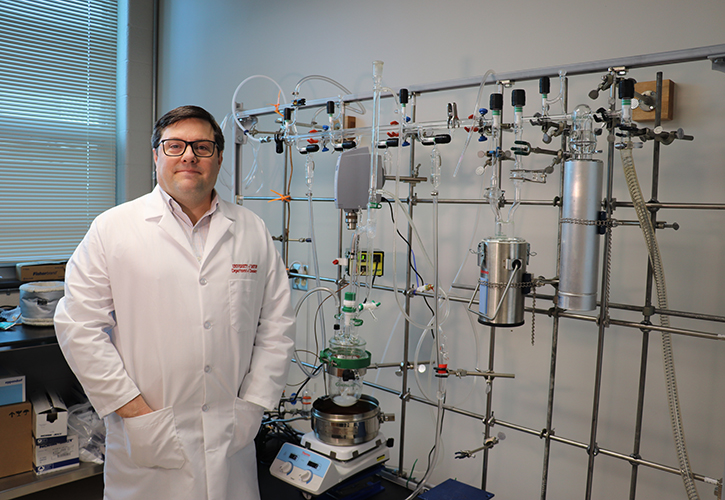College of Arts and Sciences Newsroom

UD leads $2M environmental research project
By Dave Larsen
University of Dayton chemist Justin Biffinger will lead a new $2 million federal research program to investigate how fungi degrade polyurethane-based coatings and how degradation impacts the environment.
The research project is a collaboration among the University of Dayton Department of Chemistry, Air Force Research Laboratory at Wright-Patterson Air Force Base, Naval Research Laboratory in Washington, D.C, and Central State University.
The partnership will receive a total of $2 million over four years from the Strategic Environmental Research and Development Program (SERDP), the Department of Defense’s Environmental Science and Technology program, in cooperation with the Department of Energy and Environmental Protection Agency. The University of Dayton will receive nearly $600,000 over the contract period, starting in January.
“The scope and scale of this award are indicative of what can be accomplished through collaboration,” said John Leland, University of Dayton vice president for research. “While large by normal standards, when the contributions of Justin’s collaborators are included, the total effort exceeds $2 million. More importantly, Justin will achieve a greater scientific impact by increasing the scale of his efforts through collaboration.”
The project will look at the decomposition mechanisms of molds and yeasts on polyester polyurethane coatings, how the fungi perceive those coatings and how that impacts the overall degradation process. Their goal is to predict how a given coating will respond to a fungal antagonist, without having to test every coating with every organism.
“We are trying to break apart the degradation process in order to put it back together, and then create a predictive correlation to say if a coating is going to degrade or not, or how bad the degradation is ultimately going to be,” said Biffinger, assistant professor of chemistry. He joined the University faculty in 2017 after nine years as a research chemist at the Naval Research Laboratory (NRL). He also was a National Research Council post-doctoral associate at NRL from 2006 to 2008, after receiving his doctorate in organic chemistry with emphasis in organometallic catalysis from the University of Nebraska–Lincoln.
The researchers hope to find new approaches to designing antimicrobial coatings without toxic chromates or other environmentally unfriendly additives.
Their work also could lead to new approaches to eliminating microplastics — small pieces of plastics less than 5 millimeters long that can be harmful to oceans and aquatic life. As polyester and polyurethane start to degrade, they release polyurethane blocks, a microplastic. Understanding how fungi degrade these materials could allow scientists to accelerate that process with unwanted plastics.
“The point of the program is to try to stop or slow biodegradation, but the flipside is that you need organisms that degrade polymers aggressively enough to study their biodegradation mechanisms. That means you can capitalize on these natural biodegradation pathways to also increase the degree of polymer degradation occurring in landfills or other areas where waste accumulates,” Biffinger said. “Studying organisms that can degrade polymers is ultimately transformational in mitigating the impact of plastics on the environment.”
The SERDP funding will provide project-based research opportunities for undergraduate students at both the University of Dayton and Central State — a public, historically black and 1890 land-grant university in Wilberforce, Ohio, located about 30 minutes from Dayton.
Biffinger plans to have 20 students from both schools conducting faculty-mentored summer research in his campus laboratory over the four-year span of the award. The students will have their own pieces of the research, such as characterizing individual fungal strains or synthesizing polymers.
The program proposal also calls for developing a new sustainability course between the University of Dayton and Central State, with their Air Force and Navy partners, to increase student interest in both science-related career fields and Department of Defense environmental applications and problems.
“This opportunity will facilitate authentic undergraduate research experiences for Central State students, with the main goal of enriching and nourishing their academic knowledge and technical skills,” said Leanne Petry ’95, Central State associate professor of chemistry. She holds a bachelor’s degree in chemistry, master’s degrees in materials science and exercise science, and a doctorate in materials engineering, all from the University of Dayton.
“These types of research opportunities for Central State students broadens participation of traditionally underrepresented minorities in STEM disciplines within the larger academic community,” Petry said. “This enables them to acquire a more global perspective of their field of study, promotes retention of our STEM majors, contributes to workforce development in the Dayton region, and exposes them to graduate education programs offered at neighboring universities.”
For more information, please visit the Department of Chemistry website.
